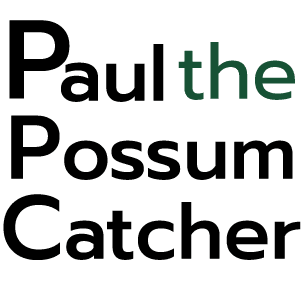POSSUMS – The brushtails, ringtails, and greater glider
Kerle, J. Anne
UNSW PRESS 2001.
The great importance of possum in the diet of Aboriginal people was recognised in early writings from the new colony. Unlike the coastal people, who relied mostly on seafood, the people between Parramatta and the Blue Mountains (the ‘inland’ people) depended more on small animals and plants. Indeed, writing in 1802, Ensign Francis Barrallier considered that possum was the most important source of protein for these people and suggested that kangaroo was caught less readily and eaten less frequently.
These inland people were described as ‘climbers of trees and men who lived by hunting’ who would ‘ascend the tallest trees after the possum and flying squirrel’ (Plate1). Methods of catching possums varied, probably depending on the country and type of possum. An 1813 painting (Plate 2) illustrates a method used by the ‘inland’ Aborigines to hunt possums. Smoke form a fire lit in the base of a hollow tree forces the possums form their hollows; a hunter then knocks them to the ground.
The stone tool technology of the area supported the importance of possums and other tree-dwelling animals in the Aboriginal diets. The edge-ground hatchet, used to enlarge the base hollows and cut toeholds in the trees, was on their most common tools. Early accounts also mention the use of traps and snares for catching possums. These would have been most useful for the Common Brushtail, which spends more time on the ground than other species.
In 1863 John Gould described in detail the importance of possums in the Aboriginal diet:
This animal constitutes a considerable part of the food of the natives, who diligently search for it, and having discovered a tree in which it is secreted, ascend it with surprising agility; the position of the animal being ascertained, a hole is cut with their little axes sufficiently large to admit the naked arm; it is then seized by the tail, the chopping and jarring of the tree not inducing it to leave its retreat, and before it has time to bite, or use its powerful claws, it is deprived of life by a blow against the side of the tree, and thrown to the ground; its captor proceeding to his encampment with a dinner in perspective. I have frequently eaten its flesh myself, and found it far from disagreeable. (From Gould’s account of ‘Phalangista (Trichosurus) vulpecula’.)
In arid and semi-arid Australia possums were common in many areas and were an important Aboriginal food source. Aborigines hunted the possums when they became
Active on moonlit nights or cut them from their tree holes. In the Flinders Ranges of South Australia possums were a primary food for the Adnyamathanha people, who would sing a special possum-hunting song before the hunt. In this area the people recall seeing fifty or sixty possums in a single tree. These recollections reinforce the fact that possums were both plentiful and important in this area. While Gould recorded that ‘the natives’ caught possums by the tail, the Flinders Ranges people suggest that the hunter had to catch hold of the head and wring it because it was impossible to pull them out by the tail.
The way of eating possum is described by Margaret-Mary Turner, a respected Arrernte woman from Alice Springs in her book Arrernte Foods:
You gut them, close them up with a wooden skewer, singe the fur off and then cook them in hot soil. When you eat them after they have been eating nectar from bloodwood trees, they taste really sweet, especially the milk guts. (p45)
The meat is reportedly quite juicy rather than being dry like rabbit and some Aboriginal people have commented that the gut and intestines can be eaten raw because it is ‘already cooked’, perhaps an effect of oils from the eucalypt leaves in the diet of the possum. Gould described the meat as ‘white and delicate, and not unlike that of a rabbit.’
